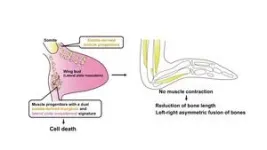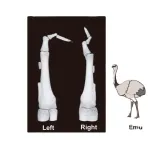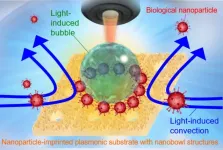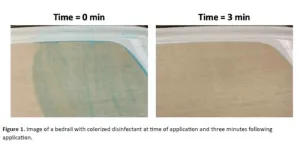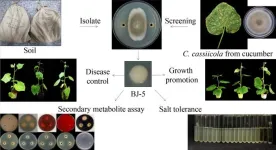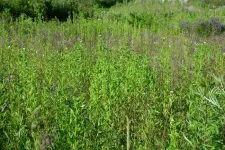(Press-News.org) A new way of making ammonia by harnessing the unique power of liquid metal could lead to significant cuts in carbon emissions caused by production of the widely-used chemical.
Ammonia is used in fertiliser to grow much of our food, but also plays a role in clean energy as a carrier to safely transport hydrogen.
The global production of ammonia, however, comes at a high environmental cost: it consumes over 2% of global energy and produces up to 2% of global carbon emissions.
RMIT Research Fellow and study lead author, Dr Karma Zuraiqi, said their greener alternative used 20% less heat and 98% less pressure than the century-old Haber-Bosch process used today for splitting nitrogen and hydrogen into ammonia.
“Ammonia production worldwide is currently responsible for twice the emissions of Australia. If we can improve this process and make it less energy intensive, we can make a large dent in carbon emissions,” said Zuraiqi, from the School of Engineering.
Results of the RMIT-led study published in Nature Catalysis show their low-energy approach to be as effective at producing ammonia as the current gold standard by relying more on effective liquid metal catalysts and less on the force of pressure.
“The copper and gallium we use is also much cheaper and more abundant than the precious metal ruthenium used as a catalyst in current approaches,” Zuraiqi said. “These advantages all make it an exciting new development that we’re keen to take further and test outside the lab.”
Liquid metal to the rescue
The team including RMIT’s Professor Torben Daeneke is at the forefront of harnessing the special properties of liquid metal catalysts for ammonia production, carbon capture and energy production.
A catalyst is a substance that makes chemical reactions occur faster and more easily without itself being consumed.
This latest study showcased their new technique by creating tiny liquid metal droplets containing copper and gallium – named ‘nano planets’ for their hard crust, liquid outer core and solid inner core structure – as the catalyst to break apart the raw ingredients of nitrogen and hydrogen.
“Liquid metals allow us to move the chemical elements around in a more dynamic way that gets everything to the interface and enables more efficient reactions, ideal for catalysis,” Daeneke said.
“Copper and gallium separately had both been discounted as famously bad catalysts for ammonia production, yet together they do the job extremely well.”
Tests revealed gallium broke apart the nitrogen, while the presence of copper helped the splitting of hydrogen, combining to work as effectively as current approaches at a fraction of the cost.
“We essentially found a way to take advantage of the synergy between the two metals, lifting their individual activity,” Daeneke said.
RMIT is now leading commercialisation of the technology, which is co-owned by RMIT and QUT.
Upscaling for industry
While ammonia produced via the traditional Haber-Bosch process is only viable at huge facilities, the team’s alternative approach could suit both large-scale and smaller, decentralised production, where small amounts are made cheaply at solar farms, which in turn would slash transport costs and emissions.
As well as obvious applications in producing ammonia for fertiliser, the technology could be a key enabler for the hydrogen industry and support the move away from fossil fuels.
“One good way to make hydrogen safer and easier to transport is to turn it into ammonia,” Daeneke explained.
“But if we use ammonia produced through current techniques as a hydrogen carrier, then emissions from the hydrogen industry could significantly increase global emissions.”
“Our vision is to combine our green ammonia production technology with hydrogen technologies allowing green energy to be shipped safely around the world without huge losses on the way,” he said.
The next challenges are to upscale the technology – which has so far been proven in lab conditions – and to design the system to operate at even lower pressures, making it more practical as a decentralised tool for a broader range of industries.
“At this stage, we are really excited by the results and are keen to speak with potential partners interested in scaling this up for their industry,” he said.
This research was supported by the Australian Research Council and the Australian Synchrotron (ANSTO). Analysis of molecular interactions was carried out at RMIT’s cutting-edge Microscopy and Microanalysis Facility, as well as QUT’s Central Analytical Research Facility, the Australian Synchrotron and via the NCI Australia supercomputing facility.
‘Unveiling metal mobility in liquid metal catalysts for ammonia synthesis’ is published in Nature Catalysis (DOI: 10.1038/s41929-024-01219-z).
Once the paper has been published online, it will be available at the following URL: https://www.nature.com/articles/s41929-024-01219-z
Authors are Karma Zuraiqi (RMIT), Yichao Jin (QUT) Caiden Parker (RMIT), Jaydon Meilak (Swinburne), Nastaran Meftahi (RMIT, Exciton Science), Andrew Christofferson (RMIT, Exciton Science), Salvy Russo (RMIT, Exciton Science), Michelle Spencer (RMIT, FLEET), Huai Yong Zhu (QUT), Lizhuo Wang (University of Sydney), Jun Huang (University of Sydney), Rosalie Hocking (Swinburne), Ken Chiang (RMIT), Sarina Sarina (QUT) and Torben Daeneke (RMIT).
MULTIMEDIA FOR MEDIA USE
Photos related to this story are available for download at this link: https://spaces.hightail.com/space/IwparT2Is3
Suggested captions:
Group photo
Dr Ken Chiang, Dr Karma Zuraiqi and Professor Torben Daeneke. Credit: Michael Quin, RMIT
Liquid metal
A new way of making ammonia by harnessing the unique power of liquid metal could lead to significant cuts in carbon emissions caused by production of the widely-used chemical. Credit: Michael Quin, RMIT
Profile photo
Dr Karma Zuraiqi holds a vial of copper, a key component of the team’s new catalyst. Credit: Michael Quin, RMIT
END
Low-carbon ammonia offers green alternative for agriculture and hydrogen transport
2024-09-19
ELSE PRESS RELEASES FROM THIS DATE:
New mechanism uncovered for the reduction of emu wings
2024-09-19
Researchers have uncovered a fascinating mechanism behind the reduction and asymmetry of emu wing bones. The wings not only show significant shortening, but the skeletal elements also fuse asymmetrically, a phenomenon traced back to the absence of muscle formation in the distal regions of the wings. During development, this lack of muscle leads to insufficient mechanical stress, which is crucial for proper bone formation. The team identified muscle progenitor cells with a unique dual identity, combining characteristics of both somite1-derived myogenic and lateral plate mesoderm2 cells. These ...
Zeroing in on the genes that snakes use to produce venom
2024-09-19
Only about ten percent of the world’s roughly 4,000 snake species have venom strong enough to seriously hurt a human, but that’s enough for snake bites to be an important public health concern. To help better understand how snakes make their venom and how venoms differ from one species to another, researchers developed a new way to zero in on the genes that snakes use in venom production. Their work was published in the journal Molecular Ecology Resources.
“We’ve developed a tool that can tell us which venom-producing genes are present across an entire snake family in one fell swoop,” says Sara Ruane, the Assistant Curator of Herpetology in the ...
Maynooth University study reveals impact of homework on student achievement in maths and science
2024-09-19
· Daily homework of up to 15 minutes most effective for maths achievement
· Homework assigned three to four times a week benefits science performance
· Short duration homework just as effective as longer assignments
Researchers at Maynooth University’s Hamilton Institute and Department of Mathematics and Statistics in Ireland have unveiled significant findings on the role of homework in student achievement. The research, led by Prof Andrew Parnell, Nathan McJames and Prof Ann O’Shea, used a new AI model to analyse data from the Trends in International Mathematics and Science ...
Reducing floodplain development doesn’t need to be complex
2024-09-19
A new paper in Oxford Open Climate Change, published by Oxford University Press, uncovers evidence suggesting that, contrary to expectations, most U.S. cities are not doing too badly in avoiding development in areas prone to flooding, and those that are effective appear to be applying existing tools and strategies well, rather than doing anything particularly novel.
Despite billions of dollars of investments and widespread mitigation efforts, the costs of disasters in the United States have grown dramatically. ...
Lights, camera, action! Coronavirus spike proteins can be selectively detected in 5 minutes
2024-09-19
Like moths to a flame, microbes can also be moved by light. Using this knowledge, researchers from Osaka Metropolitan University’s Research Institute for Light-induced Acceleration System (RILACS) have demonstrated a method to detect the presence of viruses quickly and using only a small sample.
The research team led by OMU Professor Takuya Iida, the director of RILACS, and Associate Professor Shiho Tokonami, the deputy director, report in npj Biosensing on a light-induced immunoassay. Using ...
Your Zoom background could influence how tired you feel after a video call
2024-09-19
Part of many people’s pandemic experience included working from home. Even after lockdowns, videoconferencing remains a big part of life as people continue to work remotely, connect with families and friends online, and attend virtual events hosted on videoconferencing platforms.
Spending hours on video calls, however, can be exhausting and manifest as physical, emotional, or cognitive tiredness – a phenomenon known as videoconferencing fatigue (VF). Now, researchers in Singapore have asked if a relationship between virtual backgrounds and VF exists and ...
With the use of visual cues, hospital rooms get nearly 70% cleaner
2024-09-19
With the Use of Visual Cues, Hospital Rooms Get Nearly 70% Cleaner
New study shows that a simple color additive in disinfectant wipes dramatically improved room cleanliness and even reduced time needed for cleaning
Arlington, Va. — September 19, 2024 — A new study published today in the American Journal of Infection Control (AJIC) reports a comparison of hospital room cleanliness using standard disinfectant wipes versus wipes with a color additive that allows users to see which surfaces have been sanitized. With the color additive, rooms ...
Serial-autoencoder for personalized recommendation
2024-09-19
In the last decade, auxiliary information has been widely used to address data sparsity. Due to the advantages of feature extraction and the no-label requirement, autoencoder-based methods addressing auxiliary information have become quite popular. However, most existing autoencoder-based methods discard the reconstruction of auxiliary information, which poses a huge challenge for better representation learning and model scalability.
To solve the problems, a research team led by Zhu YI published their new research on 15 August 2024 in Frontiers of Computer Science co-published by Higher Education Press and Springer Nature.
The team proposed a novel representation ...
How do look for microbes in nature that are beneficial to plant?
2024-09-19
Cucumber is a common vegetable on people’s table because of its crisp and refreshing characteristics. In order to meet the market demand throughout the year, cucumber is now mainly planted in facility greenhouses. However, the loss of soil nutrients and the accumulation of pathogenic microorganisms are inevitable in successive years of cultivation. Cucumber corynespora leaf spot, also known as cucumber target spot disease, is a major foliar disease that causes cucumber yield reduction, and its pathogen is the Corynespora cassiicola. The pathogen harms cucumber leaves, causing irregular spots and affecting the photosynthesis ...
Exotic species invasions enhance biodiversity response to climate change
2024-09-19
Globally, more than 13,000 plant species, equivalent to the entire native flora of Europe, have been naturalized outside their native ranges. A recent study, jointly conducted by scientists from China and the USA, has provided new insights about biodiversity, exotic invasion, and their relationship to climate change.
Published in Nature Plants, the research uncovers the climatic niche mechanisms that shape both the vulnerability of native ecosystems and the invasiveness of exotic species in a warming world.
A long-standing debate exists over the impact of exotic species on native ecosystems and ...

